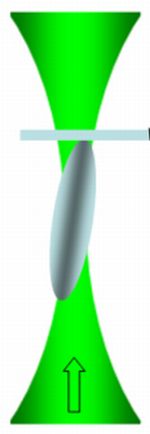EPJ E Highlight - Optical manipulation of particles of all shapes and sizes
- Details
- Published on 12 January 2015

A new study of how particles may respond to the mechanical effects of light helps improve optical manipulation and remote sensing of non-spherical particles.
Manipulation of small objects by light has gained in popularity in the past few years. Now, scientists have performed the first systematic analysis of the behaviour of ellipsoidal particles manipulated by laser beams. The work shows that such particles are constantly moving in and out of the reach of an optical beam, creating oscillations. These findings by a team of researchers from the University of Bordeaux, France, have just been published in EPJ E. This work could help understand the unusual behaviour of rod-like particles manipulated by optical tweezers. Ultimately, the theoretical part of this work could contribute numerical models of how complicated shapes and large sizes scatter laser light. Numerous applications exist in fluid engineering and remote sensing methods.
Focusing a laser beam onto a small particle, in the order of a few micrometres in size, makes the particle move. The effect is a direct consequence of light scattering. Thus, complex algorithms used for light-scattering computations may be tested by measuring the forces induced by the effect of the light beam on the particle—referred to as radiation pressure (RP).
The authors built an experimental set up capable of observing oscillating particles from different directions and measuring their characteristics. At the same time, they also developed a model of the light-particle interaction. They were thus able to calculate the radiation pressure force, induced by the laser beam, and the torque acting on the particle. Balancing such forces with hydrodynamic drag from the fluid around the particle yielded equations for the particle motion. Once solved, the equations gave computed solutions, which nicely reproduced the observed oscillations and could even predict responses that had not previously been observed.
Optically driven oscillations of ellipsoid particles. Part I: Experimental observations. B. M. Mihiretie, P.Snabre, J.C. Loudet, and B. Pouligny (2014), Eur. Phys. J. E 37: 124, DOI 10.1140/epje/i2014-14124-0
Optically driven oscillations of ellipsoidal particles. Part II: Ray-Optics calculations. J.C. Loudet, B. M. Mihiretie, B. Pouligny (2014), Eur. Phys. J. E 37: 125, DOI 10.1140/epje/i2014-14125-y





